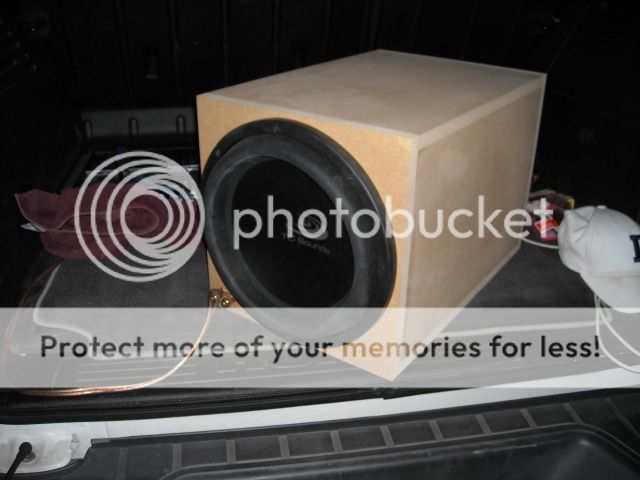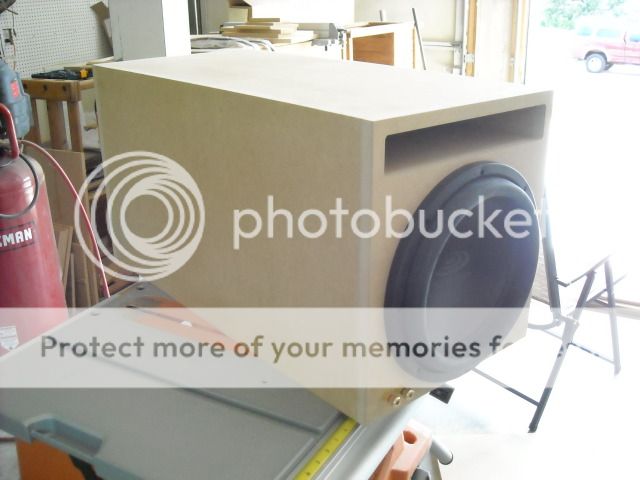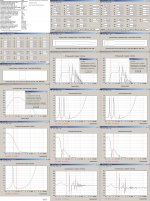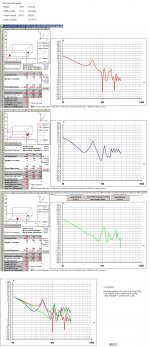Vehicle in question is a 99 Ford E350 cargo van that I am turning into a weekend camper. Oddly enough (although I have a crazy amount of room) there are few places to put an enclosure that aren't in the way of cargo room or that the drivers wouldn't be in a poor location. (like for instance firing directly at each other.)
Drivers are 2 10-inch Kicker CVR and will be driven by an 800w Kenwood mono sub amp.
My first thought was placing them behind the driver and passenger seats firing backwards so I could get as much distance for the longer waves to form, but they would get in the way of cargo. I thought about building a box between the seats to fire them backwards, but I would need an extra 1.5" between the seats to make that work.
Which got me thinking about isobaric enclosures. What are the drawbacks? Will I get the same basic SPL/SQL from an iso box or is it a whole new ball of wax? I'm a bit out of my league with this stuff.
Drivers are 2 10-inch Kicker CVR and will be driven by an 800w Kenwood mono sub amp.
My first thought was placing them behind the driver and passenger seats firing backwards so I could get as much distance for the longer waves to form, but they would get in the way of cargo. I thought about building a box between the seats to fire them backwards, but I would need an extra 1.5" between the seats to make that work.
Which got me thinking about isobaric enclosures. What are the drawbacks? Will I get the same basic SPL/SQL from an iso box or is it a whole new ball of wax? I'm a bit out of my league with this stuff.
..What are the drawbacks? ..
Hi,
My

Your driver works best in a Closed box and if used in tube ported BR box you will run into port resonance issues. Therefore IMO/IME a TL type( OD-TL = Offset Driver-TL or a Nd-TL should be considered if including a port.
An isobaric connection of drivers would cut the box internal volume requirement in half = Useful for drivers like yours as they have a high Qts value.
The expected performance would be very similar like for one diver that requires twice the box volume when compared to a isobaric pair.
Look at the pictures, especially where to place a sub.
I calculated the 'Cargo' volume and if I'm right it's about 7.5 m^3:
Normal 'cabin' gain for a small car wouldn't apply (Full Cabin gain kicks first in below~50 Hz), i.e. a program that can predict small room reflections characteristic's is IMO handy:
Room Response Calculator - Reflective Accumulation Simulation Software
b
Attachments
In a cargo van that size the longest dimension will determinn that at frequencies below about 60-70 hz the subs will operate in a pressure response not a wave response so cancellation will not be an issue.
Below this turnover frequency you can estimate approx 12db/octave boos to your low end response.
depending on the mounting locationj of your upper frequency drivers and their capacity to reach low enough you shouldnt have a trouble with localizating the bass to the installed location of the subs.
Port resonance is not an issue in car installations unless tuned VERY high(80hz).
This only occurs where you only wish to achive EXTREMELY high spl at ANY cost.
so:
To make it clear what you require answer as many of the following as you can.
required Db output @ 1m into your space
Bandwidth eg20hz to 80hz +-3db
efficency 90db/watt
Price in dollars
Power available in watts
how many systems including amp channels are to be used
Size of venue.
type of music played?
External maximum dimension?
Deal breakers? maybe highlight these parameters so we know exactly what parameters will make you abandon a design.
The Isobaric design trades efficiency for space.
Below this turnover frequency you can estimate approx 12db/octave boos to your low end response.
depending on the mounting locationj of your upper frequency drivers and their capacity to reach low enough you shouldnt have a trouble with localizating the bass to the installed location of the subs.
Port resonance is not an issue in car installations unless tuned VERY high(80hz).
This only occurs where you only wish to achive EXTREMELY high spl at ANY cost.
so:
To make it clear what you require answer as many of the following as you can.
required Db output @ 1m into your space
Bandwidth eg20hz to 80hz +-3db
efficency 90db/watt
Price in dollars
Power available in watts
how many systems including amp channels are to be used
Size of venue.
type of music played?
External maximum dimension?
Deal breakers? maybe highlight these parameters so we know exactly what parameters will make you abandon a design.
The Isobaric design trades efficiency for space.
Last edited:
required Db output @ 1m into your space
Bandwidth eg20hz to 80hz +-3db
efficency 90db/watt
Price in dollars
Power available in watts
how many systems including amp channels are to be used
Size of venue.
type of music played?
External maximum dimension?
Deal breakers? maybe highlight these parameters so we know exactly what parameters will make you abandon a design.
Required dB = no requirements. I already have the drivers and amp and simply want to make the most of the installation. I would hate to build the box for a certain spot only to find that I have odd gains or standing waves.
Bandwidth = 25Hz would be great, but realistically I think these 10s will drop more than 3dB at around 30Hz. Upper end will be determined in the future. I can stretch or shrink the low pass cutoff a bit to tailor it, but I've yet to choose mid and high drivers. I figured (instead of pushing the subs out of their comfort zone) I would choose mid drivers that are capable of filling in that range properly.
Price = not an issue. Drivers and amp (as well as plenty of MDF) has already been purchased.
Power = Amp is a Kenwood, 1-ohm stable, 900wrms bridged at 1-ohm. I'll probably wire the drivers for 4-ohm total. IIRC, the amp will provide around 650wrms at that resistance.
Type of music = Rock, classic rock, jazz, but I will admit to the occasional times when I pop in a Rap, Trip Hop, or Electronica CD and make a little hum.
I 100% appreciate the technical data, and I'm following much of it, but I'm not as savvy as you folks are. I'd like to find the placement and enclosure type to do that.
Sounds like an iso enclosure would solve the space issue, but I'm not really keen on giving up SPL just to get a smaller box. I'd rather re-engineer the box to keep it acoustic suspension if that's the case.
By the way... given the confines of the area between the front seats, I came up with this quicky drawing. At those dimensions, the chambers would give a lackluster 0.79 cuft. Extending the height to 14 inches would give me a more satisfactory 0.96 cuft.
An externally hosted image should be here but it was not working when we last tested it.
In a small space the drivers will have the least interference patterns if they are placed either at the front or back of the space, magnet side against the wall. Basically tuck it in a corner and fire out from said corner. This keeps the wall reflection close in phase to the primary wave.
Here is another quicky. This shows places that I've picked that would minimize space concerns re: cargo, seating, etc. I can build boxes for in front/behind the wheel wells that fire across the cargo area on either side (indicated by the red and blue arrows) or the previous drawing above would be represented by the green arrows (although this drawing doesn't show the seats and the cabin. It ends at the front of the cargo area.)


What is the length of the van interior from front to back.
Total length is approximately 15'. Unobstructed cargo area is 12'
Not that its the popular opinion, but if you use only one of those 10's in a ported box you get a few advantages. First, you arent driving the amp into a damping factor killing low impedance which makes the sound that much tighter. Most amps sound pretty bad at 1 ohm.
Second, the efficiency gained from the port at 30hz will likely make up for the missing second driver and the lower amp power. Since your 10's handle 800 on peaks, you arent getting an advantage feeding each with only 1/2 that power at 400. Your SPL at 25-35hz will not drop and will likely be the same or slightly better. Additionally, the ported box will help with the 10's limited excursion of 12mm since the vent takes over the job of the lower bass actually reducing cone movement at the tuning frequency which should be around 28-30hz.
Third, the amp wont be drawing as much current.
A ported 10 box will be about the same size box as required for 2 sealed subs.
I just built both ported and sealed boxes for my hummer and ultimately liked the power and lower distortion of the ported box. I know many have their favirite and never try building more than one box so some opinions are based on a particular sub never tried in more than one alignment so their opinions are limited. While almost everyone with an opinion will tell you that they built tons of sealed and ported boxes, few actually built more than one box for the same system in the same car.
Sealed:

Ported:

Added wood inside to lower box volume was done to both along with different tuning frequencies for the vent by changing length and box volume:

The info you are getting is dead on from these guys running the software and they helped me with my 100 questions but I tried various boxes to see how each sounded. I've built single 10" ported subs for friends and it forever changed their opinion of only running a single sub in a ported box.
In short, ported will likely help your situation so dont dismiss it.
Second, the efficiency gained from the port at 30hz will likely make up for the missing second driver and the lower amp power. Since your 10's handle 800 on peaks, you arent getting an advantage feeding each with only 1/2 that power at 400. Your SPL at 25-35hz will not drop and will likely be the same or slightly better. Additionally, the ported box will help with the 10's limited excursion of 12mm since the vent takes over the job of the lower bass actually reducing cone movement at the tuning frequency which should be around 28-30hz.
Third, the amp wont be drawing as much current.
A ported 10 box will be about the same size box as required for 2 sealed subs.
I just built both ported and sealed boxes for my hummer and ultimately liked the power and lower distortion of the ported box. I know many have their favirite and never try building more than one box so some opinions are based on a particular sub never tried in more than one alignment so their opinions are limited. While almost everyone with an opinion will tell you that they built tons of sealed and ported boxes, few actually built more than one box for the same system in the same car.
Sealed:

Ported:

Added wood inside to lower box volume was done to both along with different tuning frequencies for the vent by changing length and box volume:

The info you are getting is dead on from these guys running the software and they helped me with my 100 questions but I tried various boxes to see how each sounded. I've built single 10" ported subs for friends and it forever changed their opinion of only running a single sub in a ported box.
In short, ported will likely help your situation so dont dismiss it.
Last edited:
Ok, good tips all around. SpinMonster - Did you run those two boxes at the same time, or did you just do a single sealed and then switched to a single ported?
I guess what I'm thinking is that I don't want to trash the SQL by going for all-out SPL, but I also don't want to tank SPL by putting the subs in a poorly-chosen box, or a poorly-chosen location. Evidently, location in a cargo area that size isn't a huge deal. Now I just need to decide where to put them and build the darn boxes.
Anyone get a look at my colored arrows on the drawing? Do you think it would matter much if I fired them in any particular direction? The green arrows represent a dual box between the seats. And if I do go ported, which way do I fire the ports? Same direction as the cones?
I guess what I'm thinking is that I don't want to trash the SQL by going for all-out SPL, but I also don't want to tank SPL by putting the subs in a poorly-chosen box, or a poorly-chosen location. Evidently, location in a cargo area that size isn't a huge deal. Now I just need to decide where to put them and build the darn boxes.
Anyone get a look at my colored arrows on the drawing? Do you think it would matter much if I fired them in any particular direction? The green arrows represent a dual box between the seats. And if I do go ported, which way do I fire the ports? Same direction as the cones?
An externally hosted image should be here but it was not working when we last tested it.
Below 75hz the cabin will exibit pressure response, direction of the drivers and vents will have no affect on sound.
if you cross your subs over to the mids at that frequency all bass will localize to the mid location.
the only worry you need have is panel resonance and driver excursion limitation.
Expect rising response of 12db per octave from 75hz and below.
a vented enclosure tuned to 30 hz will have a rising response to 30 hz followed by a 12 db/octave falling response below 30hz, assuming a 4th order vented alignment.
Set the infrasonic filter to 25hz to protect the driver from overexcursion.
A sealed box will exibit a flat response to its excursion limited lower frequency.
Damping factor and "speed" of the enclosure will be more affected by the vehicle than the enclosure design. Most lumpy sounding bass is due to delayed panel resonances of the vehicle.
if you cross your subs over to the mids at that frequency all bass will localize to the mid location.
the only worry you need have is panel resonance and driver excursion limitation.
Expect rising response of 12db per octave from 75hz and below.
a vented enclosure tuned to 30 hz will have a rising response to 30 hz followed by a 12 db/octave falling response below 30hz, assuming a 4th order vented alignment.
Set the infrasonic filter to 25hz to protect the driver from overexcursion.
A sealed box will exibit a flat response to its excursion limited lower frequency.
Damping factor and "speed" of the enclosure will be more affected by the vehicle than the enclosure design. Most lumpy sounding bass is due to delayed panel resonances of the vehicle.
Ok, good tips all around. SpinMonster - Did you run those two boxes at the same time, or did you just do a single sealed and then switched to a single ported?
I guess what I'm thinking is that I don't want to trash the SQL by going for all-out SPL, but I also don't want to tank SPL by putting the subs in a poorly-chosen box, or a poorly-chosen location. Evidently, location in a cargo area that size isn't a huge deal. Now I just need to decide where to put them and build the darn boxes.
Anyone get a look at my colored arrows on the drawing? Do you think it would matter much if I fired them in any particular direction? The green arrows represent a dual box between the seats. And if I do go ported, which way do I fire the ports? Same direction as the cones?
An externally hosted image should be here but it was not working when we last tested it.
I ran the same 12" in 3 different ported alignments varying enclosure volume and tuning frequency. This chaged the group delay and had a dramatic effect on SQ. The best ported alignment gives up nothing to the sealed box because you have lower distortion at a given volume due to the port efficiency. Run about 15sq inches of vent area to avoid compression. I ran two different sealed displacements. One at a time in each case. Running 2 sealed subs would increase SPL but lowers the load to the amp thus lowering damping factor and SQL. I demo'ed the ported box for my friend who just covered his ears with the single 12".
As Etocynned pointed out, the sealed box will be flatter in your car but thats about it for the advantages over an optimum ported box. Why? You are very limited on power. If you run the ported box and eq to be flat, you will be lowering all the deep frequencies saving a ton of amp power which you dont have much of. This makes the ported sub work so much less and the vent itself limits cone excursion which you also dont have much of. You wont gain 6db from two 10's because your 10's handle 800 on peaks so running two only gets you 400 on peaks each so....3db. The ported box gets you 6-7db at all the deepest frequencies with minimum cone motion.
If you are concerned at all about SQL you shouldnt even be considering running the amp at 1ohm. It kills SQL across the board on every amp I've ever used which is extensive. In my opinion, the ported box at 2 ohms Eq'ed will be far better SQL than a sealed sub X 2 running 1 ohm. The best ported alignments are really close in SQL to a near optimum sealed box if its done right; if the sealed box isnt optimum you can forget the sealed being better in any way. I ran 2 sealed box sizes at .65Q and .71Q, and 3 ported alignments. I have built it all and kept the ported box so thats my 2 cents.
My observations in a big truck with big body panels is that the direction of the driver can and does aggravate body panel vibrations in my hummer. If I point it at the rear door, its violent body vibration while pointing to the drivers side stopped it. It was a simple test as the box just sits in the rear and I can turn it freely. This is something your van may or may not have issues with but it has even bigger body panels than my hummer. As far as sound of the sub, no it doesnt make the bass any better or worse.
The walls of the van will eventually be at least insulated; dynamat, foam acoustic "eggcrate" material covered with fabric, etc. There isn't much I can do to prevent movement other than adding weight and diffusion.
I also want to thank all of you for taking me through this. You could have easily just passed over this remedial thread to more interesting things, but you all chipped in and helped. Thanks so much.
I think I'll start with some ported boxes if I can find the right configuration. The worst case scenario is that I don't like it and I build some sealed boxes. I have plenty of MDF. I work at Home Depot and there were 12 sheets of 2' x 4' x 3/4" MDF on the clearance cart with a corner scuffed up for $1 each so I bought them all
I also want to thank all of you for taking me through this. You could have easily just passed over this remedial thread to more interesting things, but you all chipped in and helped. Thanks so much.
I think I'll start with some ported boxes if I can find the right configuration. The worst case scenario is that I don't like it and I build some sealed boxes. I have plenty of MDF. I work at Home Depot and there were 12 sheets of 2' x 4' x 3/4" MDF on the clearance cart with a corner scuffed up for $1 each so I bought them all
...I think I'll start with some ported boxes if I can find the right configuration. The worst case scenario is that I don't like it and I build some sealed boxes...
Good luck with your sealed boxes!
b
Good luck with your sealed boxes!
b
lol, opinions vary.
I'd say cabin gain is over-rated, since road/drivetrain/exhaust noise is a direct masking of LF output. Put the box where it fits into your use of the vehicle and then adjust to taste. Your options now are light years beyond what we could do in the 80s when I had a car audio shop.
I'd say cabin gain is over-rated, since road/drivetrain/exhaust noise is a direct masking of LF output. Put the box where it fits into your use of the vehicle and then adjust to taste. Your options now are light years beyond what we could do in the 80s when I had a car audio shop.
If that were true then we would not even know about cabin gain.
As it stands it works out to approx 12db/oct road noise is somewhat less, perhaps 3-6 db/oct.
experience tells me that cabin gain is an enormous affect on system output. You can design it into the system to save on size, or you can design for flat response and allow it to contribute to massive output at same designed power.
I Love Cabin Gain.
- Status
- This old topic is closed. If you want to reopen this topic, contact a moderator using the "Report Post" button.
- Home
- Loudspeakers
- Subwoofers
- Sub placement in my van and what type of box?

